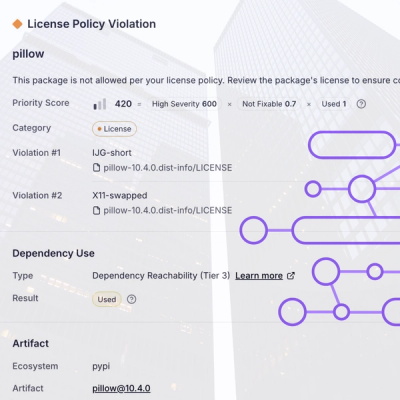
Research
/Security News
Critical Vulnerability in NestJS Devtools: Localhost RCE via Sandbox Escape
A flawed sandbox in @nestjs/devtools-integration lets attackers run code on your machine via CSRF, leading to full Remote Code Execution (RCE).
A Python library for implementing layered architecture with services and dependency injection.
LayeredPy is a Python library built to implement a clean, maintainable layered architecture. It offers support for service-oriented programming and includes built-in dependency injection (DI) to improve code modularity and testability.
layeredpy tool.Install LayeredPy using pip:
pip install layered-py
Here’s how you can use LayeredPy in your projects.
Create a service by subclassing the Service class and use the @register decorator to register it.
from layered_py.service import Service
from layered_py.decorators import register
@register(singleton=True)
class GreetingService(Service):
def say_hello(self):
print("Hello from LayeredPy!")
With the @inject decorator, services can be directly injected as attributes of the class. You don’t need to pass them explicitly.
LayeredPy uses lazy loading with the load_all_modules function to collect all classes with the register annotation. Using this function in a
central point in your software is mandatory so classes that use Inject function properly.
from layered_py.decorators import inject
from layered_py.bootstrap import load_all_modules
class MyApp:
@inject
def run(self, GreetingService):
GreetingService.say_hello() # Directly access the injected service
# Example usage
if __name__ == "__main__":
load_all_modules()
app = MyApp()
app.run()
Hello from LayeredPy!
You can use the built-in layeredpy CLI tool to create new service boilerplates automatically.
The CLI tool of LayeredPy can create services, repositories, domains and presentation classes
layeredpy createService MyNewService
This command generates the following services/MyNewService.py file:
from layered_py.service import Service
from layered_py.decorators import register
@register(singleton=True)
class MyNewService(Service):
def setup(self):
pass
def handle(self):
raise NotImplementedError
The same works with the commands: createDomain, createPresentation, and createRepository
layeredpy generateLayeredPy is capable of creating complete sets of classes for example this command:
layeredpy generate User
will create: UserService, UserRepository, UserModel and UserRoutes with the register annotation so they are DI-ready.
To change the paths where the classes will be generated create a layeredpy_config.yml in your project root
The .yml File should contain the following:
service_destination: "your_services"
domain_destination: "your_domains"
repository_destination: "your_repositories"
presentation_destination: "your_presentations"
This project is licensed under the MIT License.
For questions or support, feel free to open an issue on the GitHub Issues page. You can find more information on the project repository.
FAQs
A Python library for implementing layered architecture with services and dependency injection.
We found that layered-py demonstrated a healthy version release cadence and project activity because the last version was released less than a year ago. It has 1 open source maintainer collaborating on the project.
Did you know?

Socket for GitHub automatically highlights issues in each pull request and monitors the health of all your open source dependencies. Discover the contents of your packages and block harmful activity before you install or update your dependencies.

Research
/Security News
A flawed sandbox in @nestjs/devtools-integration lets attackers run code on your machine via CSRF, leading to full Remote Code Execution (RCE).

Product
Customize license detection with Socket’s new license overlays: gain control, reduce noise, and handle edge cases with precision.

Product
Socket now supports Rust and Cargo, offering package search for all users and experimental SBOM generation for enterprise projects.